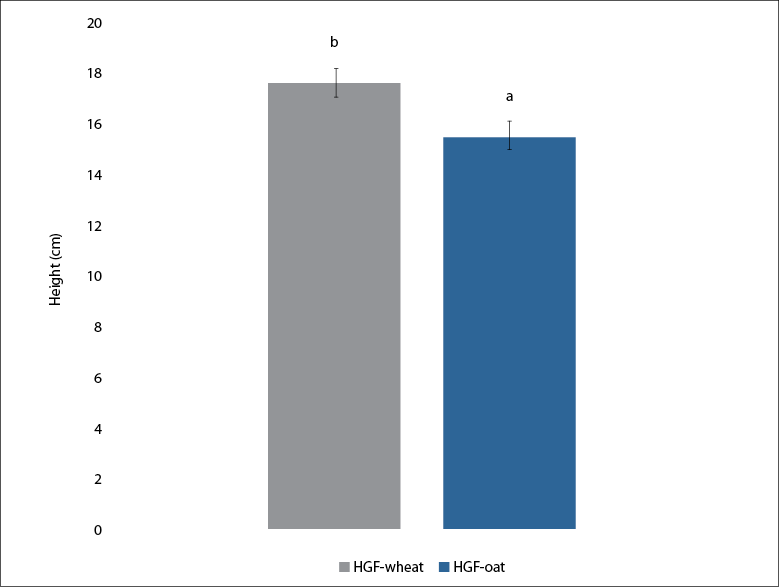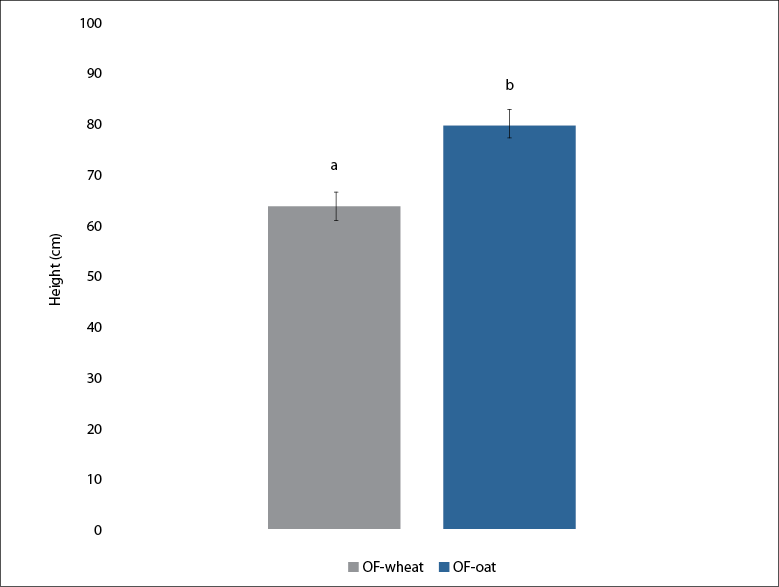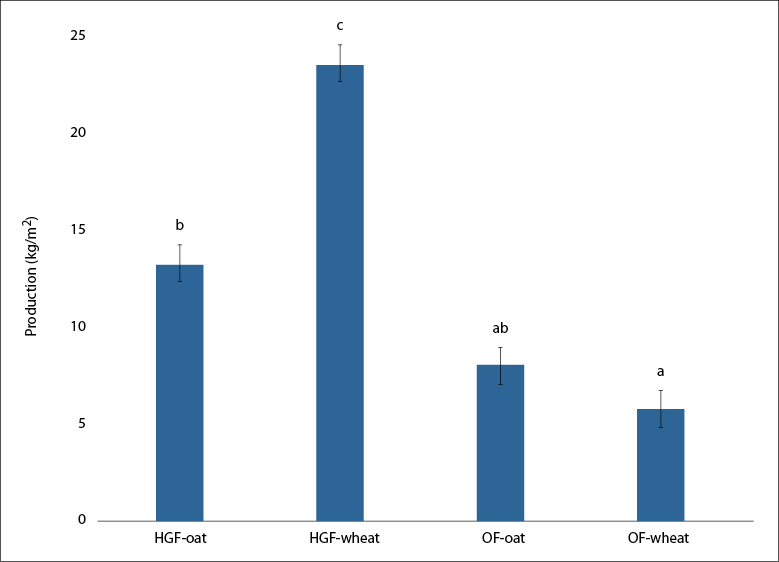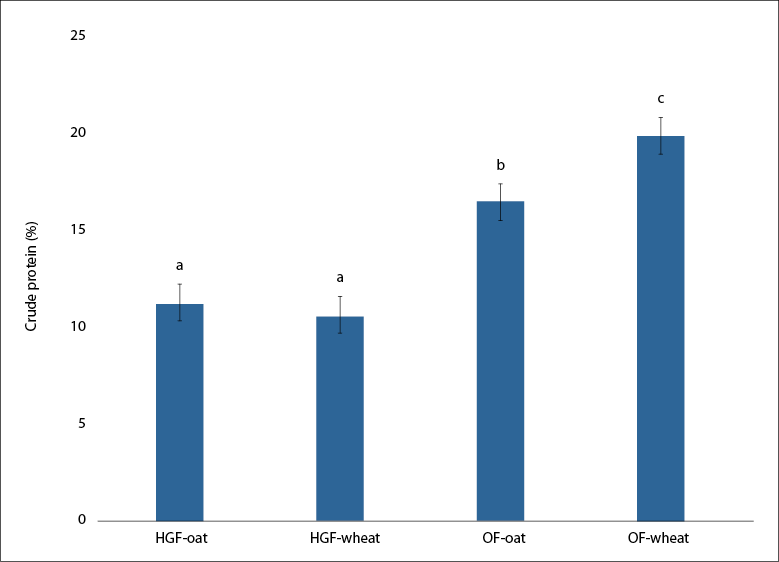Introduction
Cattle farming is the main activity in the Sierra region of Ecuador, constituting 49 % of the national total. The province of Loja occupies the fifth position of eleven that comprise the region, owning 9 % of the total cattle heads (Instituto Nacional de Estadísticas y Censos [INEC], 2016). This region has a proportion of cultivated and natural pastures of 27.86 and 74.28 %, respectively (INEC, 2016). The productivity of pastures for cattle feeding in relation to the number of animals found in this province is low due to the limited water resources and the decrease in soil fertility (Huiza, 2015). The latter is caused by severe soil degradation processes, including erosion, salinization, compaction, acidification, and contamination (De Noni & Trujillo, 1986), which motivates producers to supply livestock inputs as concentrates to complement the feeding of their animals, raising production costs.
Forage traditionally cultivated in an open field (OP) faces difficulties in its production. Urbanization growth rate forces the relocation of livestock farms to distant sectors (Vargas-Rodríguez, 2008); further, adverse climatic factors such as floods, droughts, and lack of irrigation systems lead to less production of forage produced for animal feed (Food and Agriculture Organization [FAO], 2001). This situation leads to the search or application of new technologies to improve the quantity and quality of livestock feed (Suquilanda, 2008).
Hydroponic green forage (HGF) is an alternative proposed by various authors to solve the problems of lack of food for farm animals, consisting of the production of plant biomass from initial seedling growth (Ramírez-Víquez & Soto-Bravo, 2017; Zagal-Tranquilino et al., 2016). This system has nutritional attributes suitable for animal feeding (Nava-Noriega et al., 2005) and complements forage supplementation throughout the year since it can be established in marginal and poorly fertile areas (Vargas-Rodríguez, 2008). Nonetheless, it is not widely used in the country, still less in the province of Loja, so starting with studies on this topic will be very useful for cattle producers in this area of Ecuador. According to González et al. (2015), the HGF system could bring some economic and environmental benefits for dairy and meat cattle producing farms.
Among the cereals that are cultivated under the HGF technique, oat and wheat stand out due to their good nutritional profile. Furthermore, their seeds are composed of a husk made of cellulose fibers that contain vitamins of the B group, as well as vitamin E, folic acid, germ that has unsaturated fats, and its internal almond is comprised of starch. According to FAO (2001), the most important properties of these cereals produced under HGF are the following: dry matter can reach up to 32.0 % and crude protein up to 9.0 %, which supplied as a complementary food for animal ruminants, supports the nutritional and productive processes of the farm.
Therefore, and concerning the need to improve the cattle feed quantity and quality, the development of this research work has been proposed, aiming at comparing the production and content of crude protein (CP) of forages grown both in the OF as well as in the HGF systems.
Materials and methods
Location
The research was carried out at the Agricultural Station of Universidad Técnica Particular de Loja (EA-UTPL) located in the Cajanuma sector, south of the Loja canton, 9 km from the city of Loja on the road to Vilcabamba. The EA-UTPL is part of the buffer zone of the Podocarpus National Park. It is located at coordinates X: -4.0886 and Y: -79.2066 (Google Maps, 2018) at an altitude of 2,300 m above sea level. It has annual averages of temperature and precipitation of 15.4 °C and 780 mm, respectively, according to data from the weather station "La Argelia" (TuTiempo.net, 2017).
Experimental design
A randomized block design was used to evaluate the treatments in the two production systems: HGF and OF, in each of which wheat (Triticum vulgare L.) and oat (Avena sativa L.) were cultivated. Three plots or repetitions per treatment were carried out. The treatments were identified with the following conventions:
HGF-wheat = wheat cultivated in the hydroponic green forage system.
HGF-oat = oat cultivated in the hydroponic green forage system.
OF-wheat = wheat cultivated in the open field system.
OF-oat = oat cultivated in the open field system.
In the OF production system, the study plots had the following dimensions: 2.5 x 1.0 m. Sowing was carried out through a continuous stream with a separation between rows of 20 cm (Martínez-Frías, 2012). At the beginning of the sowing season, all plots were fertilized with fertiforraje, a fertilizer commonly used in this production system. The second fertilization was carried out 45 days after sowing (das) (Garófalo et al., 2011; Villaseñor-Mir et al., 2003), harvesting in the grain filling stage, characterized by the presence of the first spikes, i.e., the moment when the crop shows the highest quality (Ramírez-Ordóñez et al., 2013).
In the HGF system, planting was carried out in plastic trays of 0.40 x 0.60 m. The dose of wet seed used in oat was 6.4 kg/m2 (Fuentes et al., 2011), and in wheat, it was 4.8 kg/m2 (Cerrillo-Soto et al., 2012). Before sowing, seeds and trays were disinfected with a 1 % sodium hypochlorite solution (10 mL/L of water) for 30 s (FAO, 2001). The seeds were rinsed with clean water and left to soak for 24 h for hydration and subsequent sowing in trays, keeping them in the dark until germination. From days 5 to 12, solutions of macronutrients (N, P, K, Ca, Mg, and S) and micronutrients (Fe, Mn, Zn, Cu, B, Cl, and Mo) were applied, with concentrations of 1.25 and 0.5 mL/L, respectively (Maldonado-Torres et al., 2013; Núñez-Torres et al., 2017), performing eight irrigations per day (FAO, 2001), and harvesting 15 das (Fuentes et al., 2011).
Variables evaluated
Plant height (PH)
In the OP system, plant height was measured every 15 d until harvest or when it was cut, analyzing the last data (during harvest). In the HGF system, PH was recorded daily from germination; similarly, the analyzed data was the final data (recorded approximately at day 16) (Campo-Rodríguez & Villar-Delgado, 2012; Salas-Pérez et al., 2010). A millimeter ruler was used to record these data. In the OF system, the measurement was taken from the base of the plant to the beginning of the spike. In HGF, the measurement was taken from the apex of the plant, looking horizontally through the forage (Fernández, 2004).
Biomass production
Fresh weight or green matter (GM) of the two crops and production systems during harvest was recorded, and the equivalent of wheat and oat fodder production was calculated for each square meter of surface (Cerrillo-Soto et al., 2012) and extrapolated for one year; then, the percentage of dry matter (DM) was determined (Harris, 1970). The same methodology was used for the HGF and OF systems.
Determination of the percentage of crude protein (CP)
Three representative forage samples from the cultures of the two systems were taken, using a 20 x 20 cm quadrant, avoiding the edges; subsequently, the sample was weighed and dried in an oven at 70 °C for 24 h before grinding. The percentage of crude protein was determined by the micro Kjeldahl method validated by Harris (1970), obtaining the percentage of total nitrogen and multiplying by the protein conversion factor 6.25 for oat, and 5.7 for wheat (Mariotti et al., 2008).
Benefit-cost analysis (B/C)
The financial indicators per m2 and year were analyzed, considering the initial investments of installing the systems, as well as the total expenses in materials and inputs of all the production systems (24 for HGF and 6 for OF), such as land rent, labor, seed, nutritional solutions, trays, irrigation system, among others; depreciation of the components of the irrigation system (pumps and hoses, among others) and metal structures were estimated. The benefit was calculated according to the income projection proportional to yield (International Maize and Wheat Improvement Center [CIMMYT], 1988). For an area of one meter per year of production of each system, the forage sale value in the local market in 2018 was employed (1.09 per kg of forage). The following equation was used:
For the analysis to be favorable, the B/C ratio must be higher than 1 (Infante-Villarreal, 1984). Data equal to 1 indicate balance, while values lower than 1, denote loss.
Results and discussion
Plant height
In the HGF system, the mean PH recorded at the end of the cycle (14 to 16 d) was 2.08 cm higher (p < 0.05) for wheat when compared to oat (figure 1).

Source: elaborated by the authors
Figure 1 Height of wheat and oat plants in the HGF systemThe columns in the figure represent the average of three repetitions of plant height values incentimeters. The bars represent the standard error of the means. Different lowercase letters mean that there are significant differences between treatments. HGF-wheat = wheat cultivated in the hydroponic green forage system; HGF-oat = oat cultivated in the hydroponic green forage system.
In the HGF system, the PH of wheat was 17.67 cm, similar to the 18.94 cm obtained by Sánchez del Castillo et al. (2013) for the same crop. On the contrary, Maldonado-Torres et al. (2013) reported 14.85 cm for wheat in Mexico, a height difference that is due to the higher planting density in this experience, which caused light competition and, consequently, etiolation. The PH of oat (15.59 cm) was lower than the 19.5 cm reported by Fuentes et al. (2011) for the same crop under similar conditions. Abarca-Reyes et al. (2016) stated that oat cultivated in HGF is harvested from day 14 and with a height of 20 to 25 cm, similar to the data on harvest days found in the current work (14 to 16 d), but different in plant height values. The lower values may be related to the differences in the shade percentage of each location and system. In this aspect, the highest heights could be directly related to production, but not necessarily to the nutritional quality of the forage. For example, Salas-Pérez et al. (2010) observed that the highest protein content occurs in the initial stages; later, there is a decrease in protein in the HGF due to plant maturation.
In the OF system, the mean PH recorded at the end of the cycle (45 d) was 2.08 cm higher (p < 0.05) for oat, when compared to wheat (figure 2).

Source: elaborated by the authors
Figure 2 Height of wheat and oat plants in the OF systemThe columns in the figure represent the average of three repetitions of plant height values in centimeters. The bars represent the standard error of the means. Different lowercase letters mean that there are significant differences between treatments. OF-wheat = wheat cultivated in the open field system, OF-oat = Oat cultivated in the open field system.
The PH of OF-oat was 82.72 cm, that is, a lower value compared to the 139.30 cm reached by Quispe and Sandy (2013), who harvested in the milky state, unlike the younger physiological state (grain filling) in which the samples of the current experience were collected. Another explanation for the difference in height between the two crops is the place where the experiment was carried out (Bolivia), which has a lower temperature and precipitation, i.e., better conditions for the development of this crop.
Plant height values for OF-wheat was 66.5 cm, a higher value than the one indicated by Ramírez-Pérez (2018), who reports 55 cm, a difference that could be due to the lower altitude above sea level (Mexico, Coahuila) and precipitation conditions of this study area compared to the current study area that has a higher temperature. Zamora-Villa et al. (2016) show an overall mean of 102 cm in wheat, higher than what was recorded in the current study; these authors harvested in a state of watery maturity, unlike the younger physiological state (grain filling) in which the samples in the current work were collected.
Second title Biomass production
Biomass production per square meter of HGF wheat was higher (p < 0.05) compared to HGF oat and the two OF treatments. HGF oat does not show a statistically significant difference compared to OF oat; finally, the OF wheat treatment recorded the lowest production (figure 3). Campo-Rodríguez and Villar-Delgado (2012) stated that HGF-produced forages are effective in avoiding digestive disorders, and provide a higher quantity of minerals, proteins, and vitamins that contribute to improving the fertility of animals, i.e., they are considered an advantage for these production systems.

Source: elaborated by the authors
Figure 3 Biomass production in the evaluated treatmentsThe columns represent the average of three repetitions of production in kg/m2. The bars represent the standard error of the means. Different lowercase letters mean that there are significant differences between treatments. HGF-wheat = wheat cultivated in the hydroponic green forage system; HGF-oat = oat cultivated in the hydroponic green forage system; OF-wheat = wheat cultivated in the open field system; OF-oat = oats cultivated in the open field system.
The production of HGF wheat (23.57 kg/m2 of GM and 3.10 kg/m2 of DM) is similar to the data presented by Cerrillo-Soto et al. (2012), with GM yields of 25 kg/m2, considered by these authors as adequate. When comparing with the results of Maldonado-Torres et al. (2013) that obtained 19.95 kg/m2, those of the current work are higher, probably related to the higher nitrogen concentration of the applied nutrient solution and the lower planting density of the crops.
Cerrillo-Soto et al. (2012) achieved HGF oat values of 13 kg/m2 (GM) (1.39 kg/m2 of DM), similar to the current research with 13.23 kg/m2 (GM) (1.39 kg/m2 of DM ), attributing the lower oat production values to low seed germination percentages, suggesting that this same issue occurred in the current work.
When comparing the results of OF wheat, 5.77 kg/m2 of GM and 1.42 kg/m2 of DM were obtained, values close to those reported by Zamora-Villa et al. (2016) that achieved 1.2 kg/m2 of DM, although their harvest stage was different (watery maturity). These values are, however, higher than those of Ramírez-Pérez (2018) that recorded 0.50 kg/m2 of DM. In the results of the OF oat, 8 kg/m2 of GM and 1.52 kg/m2 of DM were recorded, i.e., higher values than those reported by Mamani (2016), who found 2.3 kg/m2 of GM and 0.64 kg/m2 DM. These differences may be related to the fact that the authors used higher planting distances, and there are lower precipitation and fertility averages in their soils, a relevant factor considering that these parameters are closely linked to the productive yield of the crops (Espitia et al., 2012). Ramírez-Ordóñez et al. (2013) achieved 1.25 kg/m2 of DM in the grain filling stage, despite reporting lower rainfall, temperature, and altitude of the research site (Mexico, Chihuahua State).
Raw protein content
Open field wheat obtained the highest content of CP (p < 0.05) compared to the other treatments. The lowest values, without difference between them, were recorded for HGF wheat and oat. OF oat had an intermediate value. However, in all cases, values higher than 10 % were achieved, showing that they are adequate to be used in production systems for bovine feeding (Salas-Pérez et al., 2010).

Source: elaborated by the authors
Figure 4 Crude protein content (%) in the evaluated treatmentsThe columns in the figure represent the average of three repetitions of the percentage of crude protein obtained by each treatment. The bars represent the standard error of the means; the different lowercase letters represent significant differences between treatments. HGF-wheat = wheat cultivated in the hydroponic green forage system; HGF-oat = oat cultivated in the hydroponic green forage system; OF-wheat = wheat cultivated in the open field system; OF-oat = oat cultivated in the open field system.
When contrasting these data with other authors in works with similar conditions, OF wheat is observed to have a CP content of 19.90 %, i.e., a higher result compared to those of Zamora-Villa et al. (2016) who obtained 17.2 %. These authors indicate that it may be related to the seed variety, the harvest stage (watery maturity), and the conditions of the location (Mexico).
The results of CP in OF oat are 16.5 %, similar to those reported by Ramírez-Ordóñez et al. (2013), who obtained 16.6 %, both values achieved in the grain filling stage. Espitia et al. (2012) reported higher CP values with averages of 18.8 % when harvesting at the same stage, a difference that, according to the authors, may be related to the oat variety used. The performance and quality of the forage oats in OF are highly influenced by the genotype-environment interaction, not only time- but also space-related.
HGF oat showed a value of 11.26 %, i.e., a lower value than the one obtained by Fuentes et al. (2011), which reached 14.31 % on day 16 under similar conditions. In another study by Cerrillo-Soto et al. (2012), with the same system, they achieved values of 13.4 % in oat in the same harvest time, but in HGF wheat, they obtained 16.7 %. Maldonado-Torres et al. (2013) reported values of 19.0 %, indicating that the protein concentration attained at day 15 of the growth stage, tends to increase as the nitrogen concentration of the nutrient solution increases.
Valiente et al. (2016) reported results higher than 21 % of CP, higher data compared to the value of 10.61 % recorded in this study because the nitrogen concentration in the nutrient solution applied was higher and the cutting time was shorter; authors such as Herrera-Torres et al. (2010), Cerrillo-Soto et al. (2012), Albert et al. (2016) proposed harvesting between 10 and 12 d, which is when higher protein values are found. Valiente et al. (2016) reported that lower values are obtained due to the maturation and development of the structural organs of the plant. The experience of the current work coincides with the authors mentioned above, related to the need to recalculate the dosage of nutrients, especially regarding the concentration of N of the nutritive solution, since it must be raised as the HGF cultivation time progresses (Maldonado-Torres et al., 2013). However, Van Soest (1994) reported that the HGF should contain at least 7 % CP, which will guarantee that the fermentation processes of the structural carbohydrates, at least at the rumen level, can take place.
Benefit-cost analysis
The data shows that the treatment with the highest B/C ratio is HGF wheat with 1.46, which means that for each dollar invested US $0.46 of profit will be obtained, while in OF oat, a balance without profit or loss was obtained. The OF wheat and HGF oat presented results lower to 1 (table 1).
Table 1 Summary of the economic analysis of each treatment including the implementation of the system in each treatment

*Benefit/cost ratio
Source: elaborated by the authors
The cost of each system was established per square meter and for one production year. In hydroponic systems for the first production, a total of US $146.40 per square meter and US $150.43 per square meter were invested for wheat and oat, respectively. These values included equipment such as a pump, a timer, containers, seeds, trays, the irrigation system, the nutrient solution, and, from the second planting and until the 24th, a total of US $11.98 and US $16.02 per square meter were used for wheat and oat, respectively, including only costs regarding seeds, nutritional solutions, and disinfection tools, among others.
In the OF system, the cost value for each production (six per year) is US $5.54 per square meter for wheat and US $5.60 per square meter for oat, whose values include items such as seeds, fertilizers, tractor rental, and labor, among others, used in traditional management systems. A substantial difference in costs between the two crops was the price of the seed, which is US $0.80 per kilogram of wheat, and US $1.20 per kilogram of oat.
The income is based on the production obtained per square meter and projected at one year in each system: HGF wheat (23.57 kg/m2) and HGF oat (13.23 kg/m2) with 24 annual productions. OF wheat (5.77 kg/m2) and OF oat (8 kg /m2) with six annual productions and suggested values on forage prices of US $0.25 per kilogram for wheat, US $0.70 per kilogram for oat, and US $1.09 per kilogram of HGF. The cost of producing HGF is undoubtedly higher than that of OF. However, costs can be reduced with the use of recycled materials such as trays, modules, and cisterns. Besides, the initial investment is the most expensive since later the same materials are used, i.e., pump, tank, and irrigation system, among others, being able to be economically viable over more extended periods (e.g., in HGF wheat, in the current research). Likewise, it is necessary to consider other benefits such as the environmental aspect (Abarca-Reyes et al., 2016), since an HGF system can support water recycling processes by recirculating this resource in the system, space, food safety, and time (FAO, 2001), and is applicable to local conditions, justifying its implementation.
Conclusions
The HGF is shown as a complementary option to the forage-based ruminant diet due to the production, chemical composition, and financial aspects of the crop, which are also applicable to zones where there are limited areas regarding space and poorly fertile and unsuitable soils for crops.











 text in
text in 





